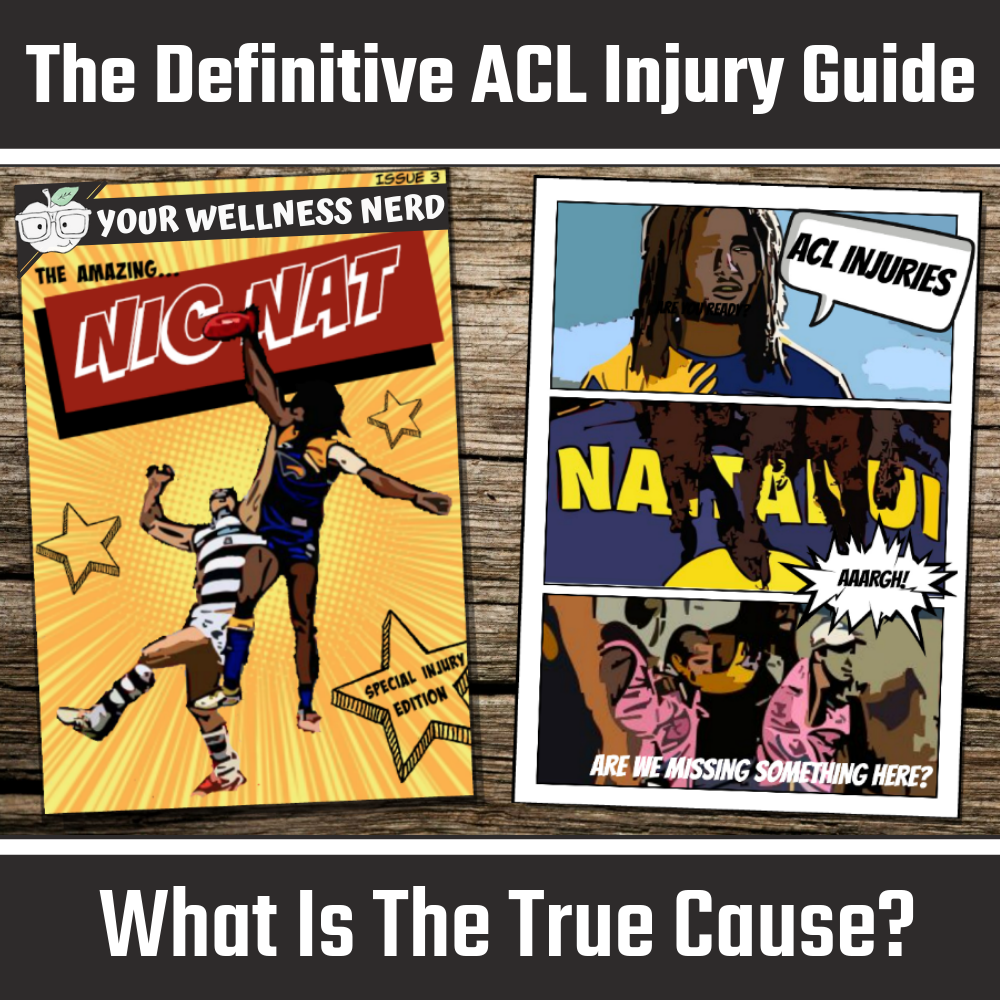Many know how devastating an Anterior Cruciate Ligament (ACL) injury can be.
There’s a long, mentally challenging rehab process and a very real chance you may re-injure yourself again.
But as a Physiotherapist (Physical Therapist) working alongside those recovering from ACL injuries every day, I’ve come to understand one thing about ACL injuries. We might be missing one crucial piece of the puzzle.
This piece might help explain why ACL injuries occur - and re-occur, beyond current cliches like bad luck and ‘moving the wrong way’.
From what I see clinically, ACL injuries may have more to do with the ankle than we realize.
As with other articles on knee tendonitis and hamstring injury, I've used another player from the Australian Football League (AFL) - Nic Naitanui, to highlight what I'm finding.
So with all that in mind, let’s comprehensively cover everything you need to know about ACL injuries and so much more.
Click here to skip straight to my findings.
What Is the ACL
The ACL is a robust knee ligament that attaches from the bottom of the thigh bone (femur) to the top of the shin bone (tibia).
It works alongside the Posterior Cruciate Ligament (PCL), Medial Collateral Ligament (MCL), Lateral Collateral Ligament (LCL) and Meniscus to support and stabilize the main compartment of the knee.
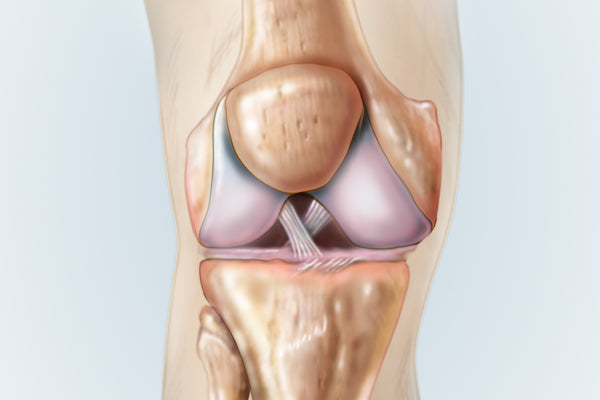
What Is an ACL Injury
The two most common ACL injuries are the ACL tear and ACL rupture.
Staggeringly, 200,000 ACL injuries occur each year in United States. That's almost one ACL torn every hour.
Not to be left out, Australia has one of the highest rates of ACL reconstruction in the world over the last 15 years.
But it doesn't stop there. Once you've had your first ACL reconstruction, you're up to six times more likely to go through another.
Unfortunately, Australia's most popular sport, the AFL, is not immune. The rate of ACL tears hasn’t shifted in 10 years despite the league's sophistication in strength and conditioning.
The Knee Injury Triad
An unfortunate by-product of an ACL injury is the damage to other structures inside the knee. In many cases, we also to see an MCL injury and/or torn meniscus. This is often referred to as the Triad.
Similarly, a nasty incident may also do bony damage to the joint surfaces of the tibia or femur and the surrounding joint capsule. These can complicate both an accurate diagnosis and subsequent rehab.
ACL Injury Symptoms
Typical signs and symptoms of an ACL injury can include:
- Knee giving way or buckling
- An audible pop or clicking sound
- Intense initial swelling
- Sudden, intense and deep knee pain
- Feeling of instability
It's worth noting that in some cases an ACL injury may not be painful. Any initial pain may quickly subside despite other ACL symptoms persisting. It's best to assume the worst until proven otherwise.
ACL Injury Cause
The following are common causes of an ACL injury:
- Sudden deceleration
- A sudden change of direction
- Landing from a jump
- Pivoting on a planted foot
- Hyperextension of knee
- Direct contact with the knee
Interestingly, you may notice the majority of these are non-traumatic. Statistically, 70% of ACL tears are non-contact. That's a huge number of potentially preventable injuries.
ACL Injury Risk Factors
Like all injuries, there are a number of factors believed to increase your risk of an ACL injury:
- Quadriceps and Hamstring muscle imbalance
- Poor general strength and conditioning
- Playing on harder, poorly maintained or artificial surfaces
- Previous ACL injury
- You are a women
- Bad luck...
What’s interesting here is that some can be modified and some cannot. And this thinking highlights a potential lack of perspective.
As a health professional, it seems we often lean on the immediately obvious factors. You hurt yourself landing or twisting so landing or twisting was likely the problem. We blame bad luck if we can’t immediately put our finger on something obvious. All of which makes perfect sense, but may also be missing the point.
Are We Missing The True Cause Of ACL Injuries?
Despite how much effort we put into ACL rehab, prediction and prevention we may still lack the necessary perspective to truly prevent them.
I still think the industry is doing an amazing job. I just think we have a tendency to get distracted by the obvious.
There will always be accidents in sport, but I feel we’ve lost sight of what’s preventable, what we can better buffer against and what we truly have no control over.
If almost 75% of all ACL injuries are not related to direct trauma, it’s almost ridiculous to suggest we can’t do a better job with prevention.
And nothing highlights this idea more than our view of women's ACL injuries.
Why Do Women Have More ACL Tears Than Men?
This is an important question. Women are upwards of ten times more likely to sustain an ACL injury than men. And our reasoning for this can be both frustrating and if I'm honest, a little insulting to women. However, it is symptomatic of how we currently view the cause of ACL injuries.
Below are some traditional answers to why women tear their ACL more than men:
- Hormones
- Differences in hip width, limb length and the relative angle at the knee (Q-angle)
- Differences in muscular strength and activation
- Smaller ACL ligaments and insertion points within the knee
- More inefficient core musculature
- Minor differences in running technique
- They are women
Again, despite these sounding plausible (bar the last one of course), the problem with these answers is two-fold.
- We promote them as being 'abnormal' when in fact they're not.
- Many of them cannot be changed.
This highlights why I think we lack perspective, particularly with women's ACL injuries.
Of course, differences exist between men and women. But these features are relative. Yes, women may have smaller parts and different bits, but all women do. Instead, we should stop thinking about women as smaller men and start comparing women to other women (and themselves).
To use differences in anatomy and physiology to excuse a ruptured ACL is to suggest that a woman's knee is an inferior design to a man's. Clearly it's not.
Both male and female knees are appropriately designed to handle the anatomy and physiology they're attached to. Otherwise, what's the point of having it?
As an introduction to what I'll get to a little later, we need to look beyond the obvious. We need to stop looking at inherently normal things as a problem. Instead, we need to focus on what these things are exposing and why.
ACL Injury Diagnosis
If you are suspicious of an ACL tear there are a few tests to consider.
The best and most efficient ACL injury test is currently the Lachman's test:
Ideally, we use a test like this to determine the need for an MRI. The degree of 'give' in the knee, any pain produced and the type of 'end-feel' can be quite accurate.
Not only can it be used to pick up an ACL tear or ACL rupture with some level of confidence, but it's also quite good at ruling one out. A correctly performed Lachman's test can give you some confidence the ACL is Ok. Although you can never be sure.
That's why we often turn to an MRI scan.
MRI For ACL Tear
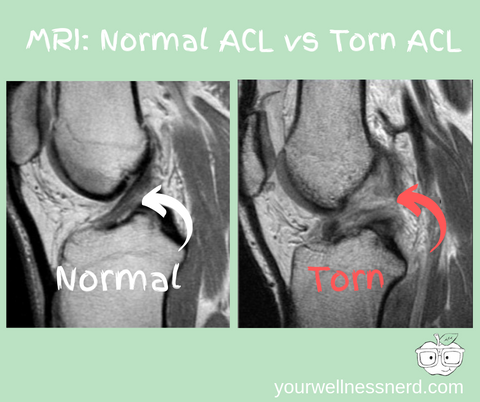
An MRI is currently the most reliable test for a torn or ruptured ACL. It can also be used during your rehabilitation to gauge how well the ligament is healing.
It can be expensive but is often a necessary evil.
ACL Injury Treatment
The treatment of an ACL injury depends on the type of injury sustained. A partial ACL tear will have vastly different consequences to a full ACL rupture in terms of rehabilitation goals and expected recovery time.
There may be subtle differences in treatment and prognosis if additional structures are also damaged.
1. Partial ACL Tear
A partial ACL tear is the best of a bad bunch when injuring your ACL.
Once through the initial swollen, painful stage, it becomes a matter of trying to keep the knee stable while the ACL heals.
A gradual return to full range of motion, strength, and conditioning is based on your progress. This will be tailored specifically to you by your Physiotherapist.
Rehab Goals After a Partial ACL Tear:
- Reduce initial pain and swelling
- Stabilize knee with an ACL brace
- Progress to normal weight-bearing ASAP
- Restore normal range of motion to the knee
- Gradually restore strength to the leg - quads (VMO), hamstrings, calves, hips, and trunk
- Re-integrate sport-specific function and conditioning
- Speed
- Agility
- Jumping and Landing
- Acceleration and Deceleration
- Endurance
Related: Here's why you shouldn't ice an injury.
Partial ACL Tear Prognosis:
Thankfully, if you've escaped the need for surgery, the recovery from a partial ACL tear can hover around 3 months. This number can increase or decrease depending on the severity of the partial tear and other associated symptoms.
Complications of a Partial ACL Tear
A partial ACL tear is clearly the more positive outcome but there are a few things to consider.
Firstly, it can leave behind some extra 'give' in the ligament. If you have your ACL physically assessed in the future, it's good to know it may feel a little looser when tested.
Similarly, it's important to factor this into your ACL rehab goals. Extra ACL laxity requires greater muscular control and better mechanics to help compensate.
2. Complete ACL Tear or ACL Rupture
Those with a completely torn or ruptured ACL will most likely face ACL reconstructive surgery.
ACL Reconstruction
Traditionally, a surgeon will take a piece of tendon from somewhere else to re-connect and reconstruct the ACL. Below is a video of an ACL reconstruction. Just be warned, it’s a little graphic and involves the full ACL reconstruction procedure.
There are five typical tendon grafts used in ACL surgery:
Autografts: Tissue from your Hamstring tendon, Patella tendon, and Quadriceps tendon can be used to fashion a new ACL. They can provide a strong scaffold for tendon healing and growth. Most evidence suggests little difference between a Hamstring vs Patella graft.
Unfortunately taking a piece of tendon from somewhere does create another local injury. It's not a significant concern as the area should heal before your knee is ready for major loading. But it is relevant if you already have a history of injury to these areas.
Allografts: This is a graft taken from someone else. Typically sourced from a donor or cadaver, this comes with its own set of challenges. They do however eliminate the harvest site dysfunction.
All four graft choices have a history of being successful, but the pros and cons need to be discussed to reach an agreed conclusion. Most of the time the surgeon will have their own preference.
Synthetic Graft: There are also synthetic options for specific cases. The most notable is the Ligament Augmentation and Reconstruction System (LARS).
What Is The LARS Graft?
LARS is an industrial-strength synthetic graft used in certain cases to provide a framework for natural ACL repair. As you can see in the video below, the LARS method can create immediate stability at the knee allowing for a much faster return to sport and activity. This method of ACL reconstruction also limits added surgical damage to the tissues of the knee. It does, however, need a certain level of ACL to be intact in order for it to be viable.
The LARS graft rose in popularity throughout the early 2000s as they promoted a faster return to sport. Nick Malceski, the AFL's poster boy for the procedure returned an astonishing 86 days after rupturing his ACL back in 2010.
This procedure has become less popular over time as long-term outcomes are not as well known.
How Long Does It Take to Recover From ACL Surgery?
Traditionally, an expected return to pre-injury activity level can take approximately 12 months post ACL reconstruction.
It's important to note this 1-year recovery timeframe can be both deflating and daunting at first. It can easily feel like you'll have your life on hold for those 12 months. And while you certainly won't be at your athletic peak until around that mark, you should expect to regain good function and quality of life far sooner.
Usually the last 8-9 months are dedicated to regaining your sport or activity-specific levels of strength, conditioning, mobility, and function.
Even if you chose not to return to sport following an ACL injury (you definitely should) you still deserve to have the required level of function for the overall health and longevity of your knee.
What Will Effect My ACL Recovery Time?
Your ACL recovery timeline will naturally change based on a number of factors:
- Type of ACL Reconstruction: As mentioned above the type of surgery can heavily influence recovery rates.
- Presence and Severity of Other Injured Structures: If you've injured other ligaments, torn the meniscus or joint capsule and/or damaged the surrounding bone, this can increase your recovery time.
- How Soon You Have the Reconstruction: It's often a good idea to wait a few weeks before having ACL surgery. This gives you time to reduce swelling, restore range of motion and get a head start on hip and trunk conditioning. The more 'prehab' you do before ACL surgery, the faster your recovery will be afterward.
- The Thoroughness of Your Rehab: The quality of your Physiotherapist and rehab program can heavily influence ACL recovery time. You can put in more effort than the next person but you need a thorough program tailored specifically to your needs.
- Previous ACL Injury: This can work both ways. If you re-injure your ACL you already know what to expect. You know what worked well and what didn't. Contrastingly, if you had a significant injury to your knee the first time, another injury to the same tissue may take longer to recover the second time around.
With this being said, try not to compare your experience to others. The specifics of the original injury alone can give someone an advantage or disadvantage in their recovery timeframe. Having said that, it’s important to feel like you’re making constant progress. At no point should you plateau.
What Happens If You Don't Have ACL Surgery?
It is always highly recommended to have the full ACL reconstructive surgery. You are designed to have functional ACLs. However, an ACL repair may not always be obtainable for a number of valid and personal reasons.
I'll say this cautiously, but you can get by without an intact ACL depending on what level of function you're happy to sacrifice. Again, 100% get the surgery if you can.
Once any initial pain, swelling, and joint fluid subside you may feel relatively good. If you can regain full joint mobility and adequate strength in the process - even better. An ACL brace may also be your best friend for a while.
But there will be a limit to what's safe for you to do. Anything too dynamic may be dangerous to the short and long-term health of your knee. It may increase your risk of knee Arthritis and make the PCL, MCL, LCL, and meniscus more susceptible to future damage. For this reason, align yourself with a trusted health professional to establish the best course of action.
Note: If this is the path you've been forced to take make sure you pay attention to any swelling or effusion (fluid). Their re-appearance can be a strong sign your knee isn't coping.
What Is the Risk of Knee Arthritis With ACL Injury?
You may be at least three times more likely to have knee Arthritis following an ACL reconstruction. This number will change based on the severity of your initial injury and the presence of other injured structures.
What Are the Chances of Tearing Your ACL Again?
Unfortunately, there's a 30% chance of re-injury in the first few years after surgery. That's a pretty high number, right? Especially considering how much time and effort goes into rehab the first time round. This is one of the reasons why injuring your ACL can be a seriously tough mental challenge.
The following are reasons why you may need a second ACL reconstruction:
- The original graft failed
- Returned to activity too early
- Rehabilitation was inadequate
Similarly, one of the major reasons why I see an ACL fail a second time is that we didn't address the reasons why it failed the first time. We'll get to what this actually means once we discuss Nic Naitanui's ACL injury.
Rehab Goals After an ACL Reconstruction:
Your ACL injury rehabilitation protocol should be specific to you and your injury. I'll endeavor to add an in-depth ACL recovery protocol to this guide in the future, but for now here are the themes to address throughout.
- Reduce initial pain and swelling
- Stabilize knee initially with an ACL brace
- Progress to normal weight-bearing ASAP
- Restore normal range of motion to the knee
- Gradually restore strength to the leg - quads (VMO), hamstrings, calves, hips, and trunk
- Demonstrate necessary motor control required to correctly perform basic functional shapes - deep squats, deadlifts
- Re-integrate sport-specific function and conditioning
- Speed
- Agility
- Jumping and Landing
- Acceleration and Deceleration
- Endurance
- Regain full confidence in your knee
- Return to sport
Related: Here's why the Marc Pro can optimize post-operative recovery.
ACL Braces
Despite their bulk and less-than-sexy appearance, an ACL brace is important post-injury. Whether you’ve partially torn your ACL or are looking to keep the knee stable post-op, it’s important to give the ligament a chance to heal.
There are a number of braces to choose from but here is an idea of what to look for.
- Lateral support
- Breathable
- Lightweight
- Durable
Halfway Summary
Unfortunately, ACL injuries can be tough. The consequences are huge considering how insignificant the incident often is. Not only that, but there’s such a high rate of re-injury. As a result, the mental and physical challenges are real.
As a medical industry, we’re pretty good at correctly diagnosing an ACL injury and helping you recover. However, we don’t yet seem to clearly understand why an ACL fails in the first place - especially considering the overwhelming majority are non-contact.
And this is what I hope to add to the conversation.
As mentioned off the top, I hope to use the misfortune of one of Australia’s best athletes to highlight what I think we’re missing with ACL injuries. These ideas may help us improve prevention and reduce the risk of re-injury.
A New Perspective on ACL Injuries
From what I see clinically, there are two major discussion points to consider if looking to better understand why ACL injury and re-injury rates are so high.
1. Use and Activity Are Normal
Human beings are designed to do the very things that often injure an ACL. To blame running, jumping, landing, twisting, etc. for injury suggests we aren’t designed to do them. It would be silly to expect a bird’s wing to injure while flying, or a fish’s tail to break down when swimming. Yet we’re often comfortable suggesting movement as the legitimate cause of ACL injury.
This is where we need a better perspective. From what I see clinically, the activities mentioned above should be considered the last straw, not the first. We just need to work out what set the knee up to fail when it did.
2. The Knee Is a Joint of Consequence
In order to figure out the root cause, we need to stop looking at an ACL injury as a knee injury.
Consider it a leg injury instead.
Your body doesn’t see the knee as an isolated knee joint floating on its own in space. It processes its function within the context of the leg.
As a consequence, the knee is heavily influenced by the hip and the ankle and governed by the lower back. If for no other reason than they're physically connected.
So if an ACL fails we need to look beyond the knee to find context.
However, the challenge here is many pre-disposing risk factors remain hidden unless you directly look for them. They aren’t often painful so it’s easy to assume you were “normal” before the injury.
But for most people living in today’s modern environment, normal is very much sub-optimal.
Furthermore, it’s vitally important to figure these factors out if you’ve had an ACL reconstruction. If they’ve compromised your knee once there’s every chance they could do it again - completely unnecessarily.
And with the help of Nic Naitanui, here is what I've come to understand about the potential cause of ACL injury.
What I'm Finding Clinically
Through my work as a Physiotherapist I've come to understand this:
Compromised leg mechanics have the biggest say in what happens to your ACL.
This is beyond bad luck, moving the wrong way, accidental contact, being a woman and misuse.
So what seems to create the biggest compromise to our leg mechanics and directly sets the ACL up to fail?
Ankle stiffness.
Ankle Stiffness
Clinically, I'm finding that ankle stiffness, or the effect of ankle stiffness on normal movement patterns, is one of the biggest factors associated with an ACL injury.
To clarify, I'm not necessarily talking about ankle muscle tightness here. We're talking deep, capsular stiffness. A rusty joint if you will. There will always be accompanying muscular tightness as well, but this is often a consequence of the deeper joint restriction.
The idea here is that stiffness at the joint below the knee forces the entire leg to compensate. Ankle stiffness subtly forces the leg to collapse and rotate inwards in order to find a way around. This 'valgus' movement leaves the knee consistently at risk due to its basic hinge design.
This default pattern can be seen when watching someone land from a jump.
The first 17 seconds of this video does a great job of highlighting what a collapsed leg position looks like.
Notice how his knees meet together, albeit intentionally. Ankle stiffness will make this a reality if you need more flexibility than you have access to.
It's often hard to notice during real-time dynamic movements like jumping and landing. So it’s great this can be seen in slow motion.
Thankfully we can see this exact shape more clearly when looking at you squat deep.
The Bottom Position of a Squat
Take note of this image of Kelly Starrett, founder of MobilityWOD:

This is what the human body should easily be able to do. At any age.
In my experience, the ideal expression of full lower limb mobility is as follows:
- Feet straight
- Knees rotated fully out
- Arches “up”
- Heels on the ground
- Back straight
- Bum sits “deep”
- No sense of falling backward
It may seem silly to some that this is normal. But it is. Most have just unknowingly lost the ability to do it thanks to years of sitting and heeled shoes.
And this is why the deep squat is such a good measurement of normal function - and translates well when wanting to prevent ACL injuries.
If your ankles are stiff there’s a high likelihood you won’t make it to the bottom with good form. You can either do it or you can’t.
Instead, you’ll see feet that turn out, knees that collapse inwards, arches that flatten, back that rounds, heels that lift off the ground and people that want to fall backward. As a consequence, you’ll see an ACL open to rupturing.
In short, an ACL injury should be seen as the moment a person’s pre-existing poor mechanics fail them. This is regardless of how good an athlete they are or how previously painless or injury-free they have been.
Other Mechanical Factors For ACL Injury
Clinically, other mechanical issues may increase ACL injury risk:
- Reduced rotational hip mobility
- Sub-par rotational hip control
- Reduced rotational hip strength
- Poor general posture
- Inadequate core strength
- Inadequate ability to self-brace the spine
- Low back dysfunction
There’s a lot to unpack here but a stiff ankle seems to be the most uncompromising and influential of the lot.
Once you see the mechanical consequences attached, they're impossible to unsee.
Nic Naitanui
This is where I’d like Nic Naitanui’s help to highlight what I’m seeing clinically with ACL injuries. His ankles are brutally stiff. But first, let’s get to know him quickly.
Who Is Nic Naitanui?
Nic Naitanui is a Ruckman in the AFL. And he's an athletic freak.

Drafted to the West Coast Eagles in 2008, he was immediately billed as someone people would flock through the gates to see. Playing a position traditionally dominated by big and strong but ultimately lumbering giants, Nic Nat’s athletic gifts and dynamic gameplay was something rarely seen before.
Nic Nat still holds the AFL Draft Combine record for the Running Vertical Jump (102 cm/41 inches) and has built his career upon jumping higher and being more athletic than everyone else.
Here’s a sample of his high-marking gameplay:
He earned All-Australian selection in 2012 and has won numerous games for the Eagles over the years. This must-watch effort against North Melbourne in 2013 is the stuff of legend:
As you can see, he’s quick, he’s powerful and he’s strong – yet his ACLs have unfortunately still failed him.
And I think I know why.
Nic Naitanui's Leg Mechanics
Here's a link to the moment Nic Nat, unfortunately, ruptured his left ACL back in 2016.
The moment Nic Naitanui injured his left ACL in 2016.https://t.co/InCrW6ORVG
— Your Wellness Nerd (@yourwellnessnrd) May 27, 2019
Similarly, here's the incident that leads to his second ACL injury, this time to his right knee in 2018.
Nic Naitanui has suffered a knee injury and will not return today.#AFLPiesEagles pic.twitter.com/A0Z30A2KEy
— AFL (@AFL) July 15, 2018
Notice how innocuous both were. No-one fell across his knees. They didn't buckle in a tackle.
Next, take a good look at the direction his knees collapse. It's more obvious in the second clip. Can you see the subtle shunt inwards?
Look familiar?
Furthermore, here is a really interesting video Nic posted to Twitter in July 2017. This was almost a full year after his first ACL injury (left knee), and approximately one year before his second ACL injury (right knee):
Learning the art of flight again...I'm comin' #justdoit #godspeed pic.twitter.com/WuDZqygwvk
— Nic Naitanui (@NicNat) July 13, 2017
Watch what happens to his knees, feet, and ankles at the 15-second, 22-second, and 51-second marks.
They violently shunt inwards each time.
With all due respect to the great man, this is a consequence of how stiff his ankles seem to be.
For example; when he lands at 38 seconds notice how little give they have. His ankles run out of room very quickly. Note the huge amount of stress displaced through his entire leg.
Now compare these shapes to when Nic Nat injured each ACL again.
They're a carbon copy.
These movement patterns are symptomatic of what I see clinically every day.
Nic Naitanui and the Deep Squat
To tie things together, let's look at Nic Nat in a deep squat.
Here’s a picture of him squatting from the very game he most recently re-injured himself.

His heels are off the ground. Those ankles look stiff if this is a true representation of how he squats.
Furthermore, here are some interesting images of other athletes who’ve torn an ACL. Again, a single image may not show the truth about someone’s mechanics, but there’s something here nonetheless.
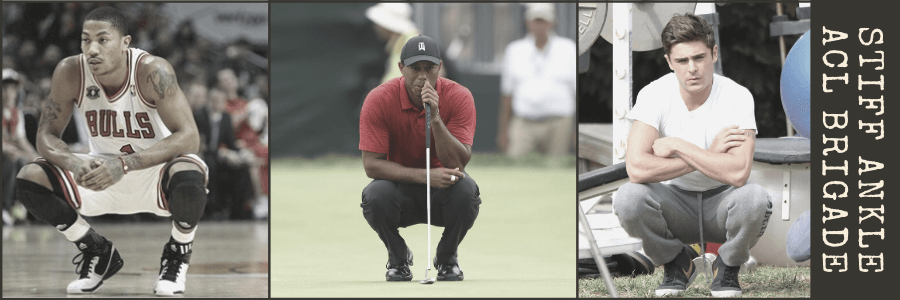
Above are images of fellow ACL injury victims. We have NBA star Derrick Rose (injured left knee in 2012), Golf legend Tiger Woods (left knee in 2007) and actor Zac Efron (left knee in 2019). Notice how each lift their heels when they squat deep.
As an aside, check out Zac Efron's Instagram account. Notice anything about the shape of his left leg in his profile pic?
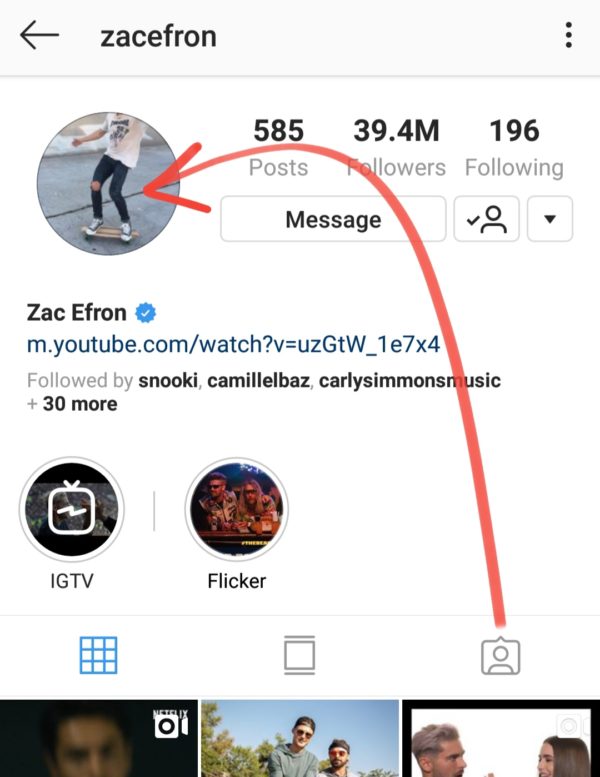
Again, these are all just images, but they highlight similar patterns.
One of the most famous ACL injuries occurred to NFL star Robert Griffin III (RG3) in 2013.
Below is the incident. Again, a basic movement injured his right knee.
Interestingly, RG3’s inwards collapse had already been well documented. Below is a low-quality set of images from his 2012 combine.

You can clearly see his knees spectacularly cave in as he goes to jump. If this is normal for him, it's no surprise something innocuous exposed his already vulnerable mechanics later on. After all, he'd likely been reinforcing that poor pattern beforehand.
What About Those With Stiff Ankles Who Don't Injure Their ACL?
This is an important counterpoint to make. You can have stiff ankles and never hurt your ACL. Like smoking, not everyone who smokes will get lung cancer. However, those with lung cancer are all highly likely to have been smokers. From this, we expect that smoking, while not guaranteeing cancer, is highly likely to be linked.
It’s important to understand that almost all ACL injuries demonstrate vulnerable mechanics.
Similarly, these same vulnerable mechanics will put a handbrake on peak performance and leg function – which is far easier to assess.
Clinically, you can free up a stiff ankle and see an immediate improvement in function and capacity. We can see a relative improvement in squat capacity (technique and depth), functional strength, agility, etc. All by allowing the knee to revert back to a better functional position.
In Nic Nat’s case, more ankle range should equal less violent collapsing. This would give him a bigger buffer against ACL injury.
Staggeringly, imagine improving the mechanics of already amazing athletes like Nic Naitanui, Tiger Woods, RG3, etc. Image how much more athletic they could be if these handbrakes were removed.
What About Traumatic ACL Injuries?
To round this off, we still need to address those who’ve had genuinely accidental ACL injuries. We’re talking those who’ve had someone or something fall across their leg. Those who were twisted the wrong way in a tackle or fell. Obviously accidents happen.
There comes a point where significant trauma or impact will damage even the most robust knees. But your mechanical competency still counts.
The better your leg mechanics, the greater buffer you’ll have against these accidents.
If your ankle or hip is already stiff and your leg gets caught, you won’t have as much room to absorb the impact before the ACL gets involved. Again, the trauma may be too great regardless, but there’s a strong percentage of people who should have made it out ok but didn’t because the rest of their leg was lacking.
What About Hypermobility and ACL Injuries?
We can apply these same ideas to those considered hyper-mobile.
Ankle stiffness may not be the main concern in this instance. Instead, we need to make sure those hypermobile joints are well controlled.
The ability to resist inwards collapsing (hip control/strength) can be just as crucial as stopping forced collapsing (stiff ankles/tight hips).
In short, nothing is guaranteed with any injury let alone an ACL. But years of hindsight and pattern recognition provide a tangible link between sub-optimal mechanics, poorer function and mechanical failure.
Best Ankle Stretch
If you’re looking to free up a stiff ankle look no further than the banded ankle stretch (below). It has the potential to be one of the most important ACL injury prevention exercises.
We want something to directly bias the deeper joint capsule, which is why a power band is so important.
How To Do The Banded Ankle Stretch:
- Hook a power band around your ankle joint
- Step forward with your feet straight and create as much band tension as comfortable
- Bend your back ankle (keeping your knee rotated out - don't let it cave in)
- Hold for 1-2 minutes
- Repeat as often as necessary
When doing the banded ankle stretch make sure you test out your squat depth before and after. You should expect to feel an immediate difference.
For exercises to help improve hip rotation and low back mobility please check out my article on why the power band has revolutionized modern stretching.
Other Important Rehabilitation Considerations
Strength and conditioning will always play an important role in any ACL recovery program. However, we need to place more emphasis on improving the way we move.
We need to regain the ability to maintain a stable knee and limit any inward collapse. Removing ankle stiffness clearly helps but we also need to retrain the hips.
Squats and Deadlifts
I find squat and deadlift shapes (and their limitless variations) to be some of the best ACL rehabilitation exercises to master during rehab. The key is to maintain both a straight, well-braced spine and an external rotation force at the hip (knees out) throughout each movement.
In full flight, this basically looks like a back that stays perfectly straight, knees that stay out and arches that remain neutral.
These basic expressions of human movement engage all the major muscle groups needed for proper leg function - and they're versatile. They can be scaled all the way down to getting up from a chair and hip hinges post-op. They can also be scaled up to weighted single-leg box jumps, agility work, and weighted, single-leg deadlifts when looking to return to sport. Normal human capacity suggests this should even include less traditional shapes like the front squat and snatch positions.
To put it simply, we need to make previously vulnerable mechanics more iron-clad. You need to remove any restrictive handbrakes at the ankle, hip, and low back while retraining more robust and functionally sound movement patterns.
Conclusion
An ACL injury can be devastating. One moment you've never had a knee injury and the next you're forced to confront your athletic mortality and many months of physical and mental torment. And then you might have to go through it all again.
From what I see clinically, they may not be the sudden, knee-specific dose of bad luck we so often promote them to be.
Instead, they may, in fact, be a failure of already vulnerable leg mechanics to tolerate a less than ideal situation. One that in a perfect world, should pose no threat to the structure of your knees.
Here are some strong takeaway points to consider with ACL injury:
- Traditional causes (landing, pivoting, bad luck, etc.) may expose a flaw rather than create one.
- Ankle stiffness may be the biggest contributing factor to ACL injuries.
- Hip mobility/control and low back function also seem to consistently fly under the radar.
- Strength and conditioning are clearly still important.
- Deep squats are a great way to appreciate the mechanical sacrifices your leg makes on your behalf.
So with all this in mind, hopefully, you can appreciate how Nic Nat’s run of ACL injuries – and many others, aren’t necessarily bad luck.
At least this is what I’m finding at work every day.
The answers are right there in front of us. We just need to take a step back to see them.
- Grant

